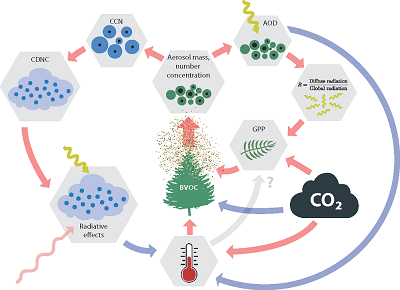The PhD defence and trial lecture are fully digital and streamed using Zoom. The host of the session will moderate the technicalities while the chair of the defence will moderate the disputation.
Trial lecture
Anthropogenic climate change: exploring the drivers and impacts with Earth System Models
Conferral summary (in Norwegian)
All vegetasjon frigir organiske gasser, såkalte BVOCer. Disse oksideres i atmosfæren og danner deretter små partikler som påvirker skydannelse og dermed også klimaet. I denne avhandlingen undersøkes denne koblingen mellom BVOC utslipp og klima ved bruk av en klimamodel. I tillegg presenteres en ny måte å modellere dannelsen av nye partikler i atmosfæren.
Main research findings
Popular scientific article about Blichner’s dissertation:
From trees to cloud seeds: Modelling the climate influence of biogenic volatile organic compounds with the Norwegian Earth System Model
When the climate warms, vegetation may counteract this through the increased emissions of gases, so called biogenic volatile organic compounds (BVOCs). These compounds produce particles in the atmosphere which then act as cloud seeds, resulting in brighter, more reflective and cooling clouds.

This thesis aims to improve our understanding of how important BVOCs are for the climate and how uncertain the associated processes are. A state-of the-art climate model, the Norwegian Earth System Model (NorESM), is used and developed for this purpose. Findings show that increased BVOC emissions resulting from a warmer climate, may substantially counteract said warming. In fact as much as 13% of the warming associated with a doubling of CO2 concentrations may be offset in this way.
Furthermore, the thesis presents the development of a new scheme for modelling the formation of new particles from the gas phase in the atmosphere, using a sectional scheme instead of the default modal scheme for the very smallest particles. The new scheme is shown to improve the representation of particles in the model and decreases the estimated cooling from aerosol-cloud interactions since pre-industrial time with 0.13 W/m2 compared to the default model.
Photo and other information:
Press photo: Sara Marie Blichner, portrait; 800px. Photo: Private
Other photo material: Figure with description and credit as specified in the article above, size 1000px.
